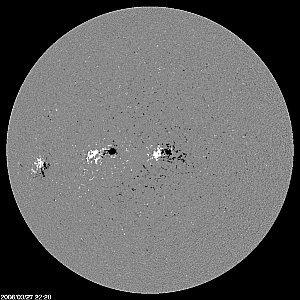 Magnetic activity on March 27th; white indicates N
Magnetic activity on March 27th; white indicates N
magnetic poles, black S. Credit: ESA/SOHO/NASA.
A few blogs back I wrote about the 11-year cycle of ups and downs in solar activity--the Solar Cycle --and how over the last year or so the baton was supposedly passed from Cycle 23 to Cycle 24. But there has been an occurrence on the Sun that suggests we may be in somewhat of a gray zone….
For the past two or three years, the Sun has been downright boring. We set up our Sunspotter telescopes for visitors and try very hard to make what we see seem interesting--"See that perfectly blank circle of light? That’s the Sun! Really it is!"
About a week ago, the tedium was suddenly broken by a train of sunspots that rotated into view on Sun’s disk. Five--count'em-- five sunspots! Finally, something to actually look at! And in the eyepiece of our Coronado Hydrogen-Alpha filter telescope there were filaments and plage! What are filaments and plage? Exactly! People wanted to know….
Then came the weird part: these were not Cycle 24 sunspots (I am not the Dread Pirate Roberts…); they were refugees from the supposedly defunct Cycle 23. While the distinction may be a fine point that doesn’t worry most of our visitors, it can still be a good talking point.
